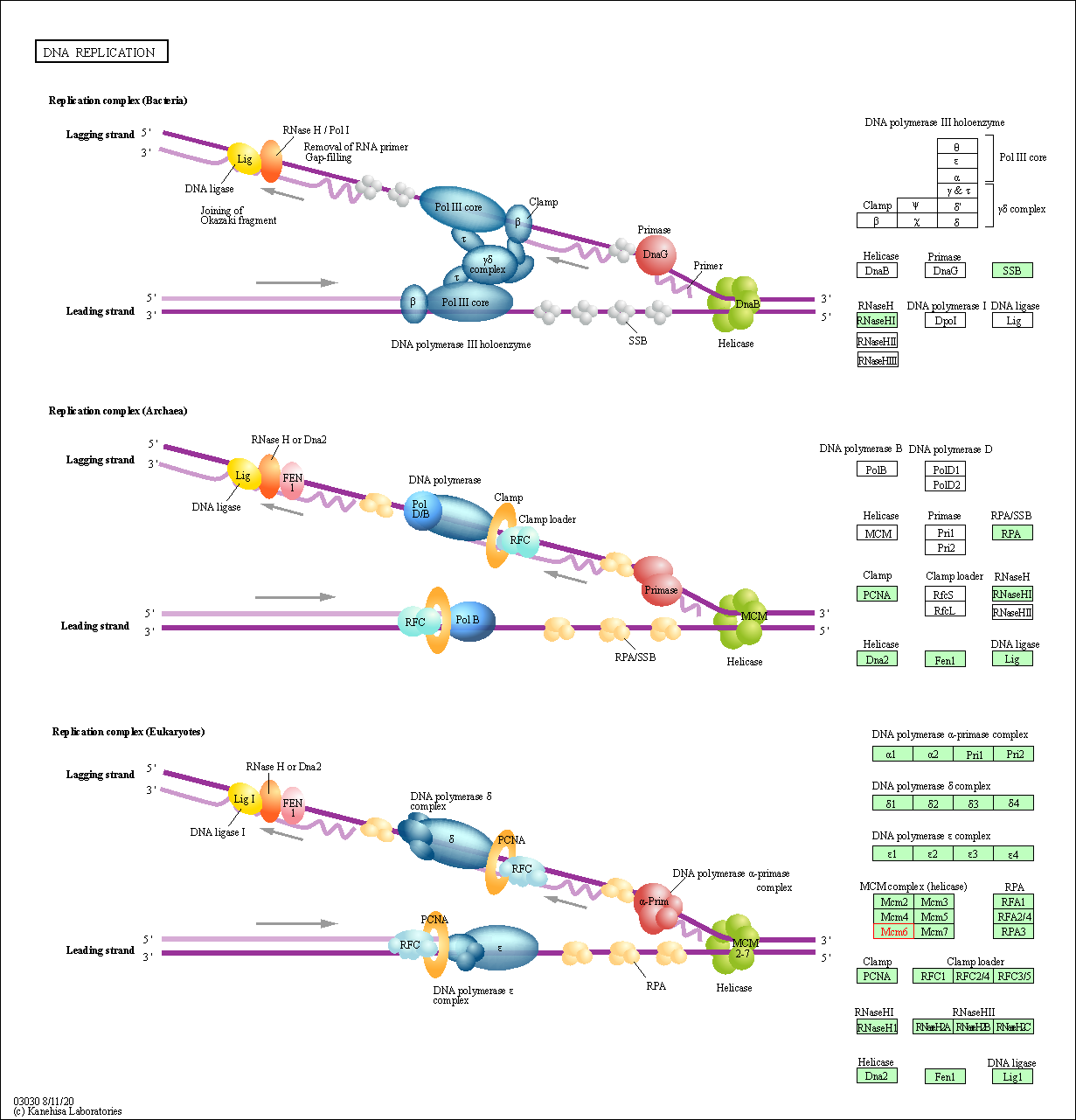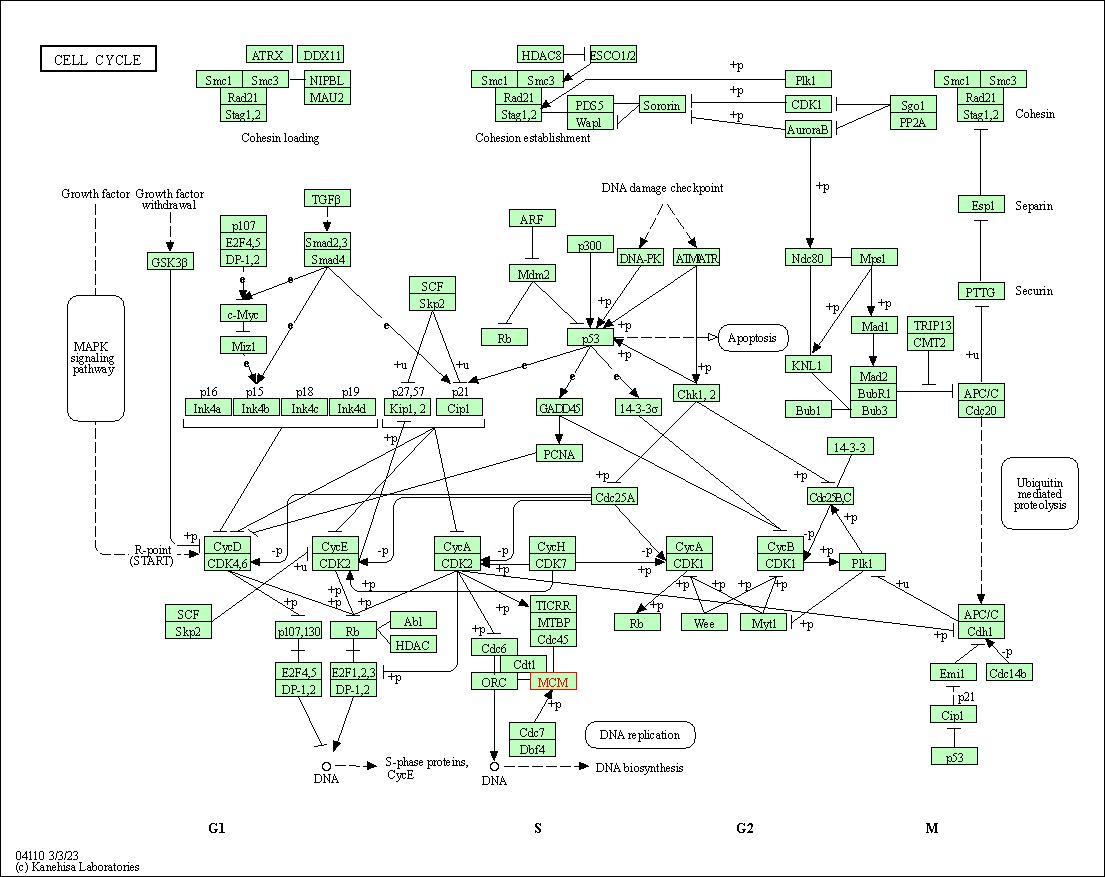Target Information
| Target General Information | Top | |||||
|---|---|---|---|---|---|---|
| Target ID |
T30502
(Former ID: TTDR00491)
|
|||||
| Target Name |
DNA replication licensing factor MCM6 (MCM6)
|
|||||
| Synonyms |
p105MCM; Minichromosome maintenanceprotein 6
Click to Show/Hide
|
|||||
| Gene Name |
MCM6
|
|||||
| Target Type |
Literature-reported target
|
[1] | ||||
| Function |
The active ATPase sites in the MCM2-7 ring are formed through the interaction surfaces of two neighboring subunits such that a critical structure of a conserved arginine finger motif is provided in trans relative to the ATP-binding site of the Walker A box of the adjacent subunit. The six ATPase active sites, however, are likely to contribute differentially to the complex helicase activity. Acts as component of the MCM2-7 complex (MCM complex) which is the putative replicative helicase essential for 'once per cell cycle' DNA replication initiation and elongation in eukaryotic cells.
Click to Show/Hide
|
|||||
| BioChemical Class |
Acid anhydride hydrolase
|
|||||
| UniProt ID | ||||||
| EC Number |
EC 3.6.4.12
|
|||||
| Sequence |
MDLAAAAEPGAGSQHLEVRDEVAEKCQKLFLDFLEEFQSSDGEIKYLQLAEELIRPERNT
LVVSFVDLEQFNQQLSTTIQEEFYRVYPYLCRALKTFVKDRKEIPLAKDFYVAFQDLPTR HKIRELTSSRIGLLTRISGQVVRTHPVHPELVSGTFLCLDCQTVIRDVEQQFKYTQPNIC RNPVCANRRRFLLDTNKSRFVDFQKVRIQETQAELPRGSIPRSLEVILRAEAVESAQAGD KCDFTGTLIVVPDVSKLSTPGARAETNSRVSGVDGYETEGIRGLRALGVRDLSYRLVFLA CCVAPTNPRFGGKELRDEEQTAESIKNQMTVKEWEKVFEMSQDKNLYHNLCTSLFPTIHG NDEVKRGVLLMLFGGVPKTTGEGTSLRGDINVCIVGDPSTAKSQFLKHVEEFSPRAVYTS GKASSAAGLTAAVVRDEESHEFVIEAGALMLADNGVCCIDEFDKMDVRDQVAIHEAMEQQ TISITKAGVKATLNARTSILAAANPISGHYDRSKSLKQNINLSAPIMSRFDLFFILVDEC NEVTDYAIARRIVDLHSRIEESIDRVYSLDDIRRYLLFARQFKPKISKESEDFIVEQYKH LRQRDGSGVTKSSWRITVRQLESMIRLSEAMARMHCCDEVQPKHVKEAFRLLNKSIIRVE TPDVNLDQEEEIQMEVDEGAGGINGHADSPAPVNGINGYNEDINQESAPKASLRLGFSEY CRISNLIVLHLRKVEEEEDESALKRSELVNWYLKEIESEIDSEEELINKKRIIEKVIHRL THYDHVLIELTQAGLKGSTEGSESYEEDPYLVVNPNYLLED Click to Show/Hide
|
|||||
| 3D Structure | Click to Show 3D Structure of This Target | PDB | ||||
| HIT2.0 ID | T75IWG | |||||
| Cell-based Target Expression Variations | Top | |||||
|---|---|---|---|---|---|---|
| Cell-based Target Expression Variations | ||||||
| Different Human System Profiles of Target | Top |
|---|---|
|
Human Similarity Proteins
of target is determined by comparing the sequence similarity of all human proteins with the target based on BLAST. The similarity proteins for a target are defined as the proteins with E-value < 0.005 and outside the protein families of the target.
A target that has fewer human similarity proteins outside its family is commonly regarded to possess a greater capacity to avoid undesired interactions and thus increase the possibility of finding successful drugs
(Brief Bioinform, 21: 649-662, 2020).
Human Tissue Distribution
of target is determined from a proteomics study that quantified more than 12,000 genes across 32 normal human tissues. Tissue Specificity (TS) score was used to define the enrichment of target across tissues.
The distribution of targets among different tissues or organs need to be taken into consideration when assessing the target druggability, as it is generally accepted that the wider the target distribution, the greater the concern over potential adverse effects
(Nat Rev Drug Discov, 20: 64-81, 2021).
Human Pathway Affiliation
of target is determined by the life-essential pathways provided on KEGG database. The target-affiliated pathways were defined based on the following two criteria (a) the pathways of the studied target should be life-essential for both healthy individuals and patients, and (b) the studied target should occupy an upstream position in the pathways and therefore had the ability to regulate biological function.
Targets involved in a fewer pathways have greater likelihood to be successfully developed, while those associated with more human pathways increase the chance of undesirable interferences with other human processes
(Pharmacol Rev, 58: 259-279, 2006).
Biological Network Descriptors
of target is determined based on a human protein-protein interactions (PPI) network consisting of 9,309 proteins and 52,713 PPIs, which were with a high confidence score of ≥ 0.95 collected from STRING database.
The network properties of targets based on protein-protein interactions (PPIs) have been widely adopted for the assessment of target’s druggability. Proteins with high node degree tend to have a high impact on network function through multiple interactions, while proteins with high betweenness centrality are regarded to be central for communication in interaction networks and regulate the flow of signaling information
(Front Pharmacol, 9, 1245, 2018;
Curr Opin Struct Biol. 44:134-142, 2017).
Human Similarity Proteins
Human Tissue Distribution
Human Pathway Affiliation
Biological Network Descriptors
|
|
|
There is no similarity protein (E value < 0.005) for this target
|
|
Note:
If a protein has TS (tissue specficity) scores at least in one tissue >= 2.5, this protein is called tissue-enriched (including tissue-enriched-but-not-specific and tissue-specific). In the plots, the vertical lines are at thresholds 2.5 and 4.
|
| KEGG Pathway | Pathway ID | Affiliated Target | Pathway Map |
|---|---|---|---|
| DNA replication | hsa03030 | Affiliated Target |

|
| Class: Genetic Information Processing => Replication and repair | Pathway Hierarchy | ||
| Cell cycle | hsa04110 | Affiliated Target |

|
| Class: Cellular Processes => Cell growth and death | Pathway Hierarchy | ||
| Degree | 44 | Degree centrality | 4.73E-03 | Betweenness centrality | 1.12E-04 |
|---|---|---|---|---|---|
| Closeness centrality | 2.14E-01 | Radiality | 1.38E+01 | Clustering coefficient | 4.88E-01 |
| Neighborhood connectivity | 4.02E+01 | Topological coefficient | 1.22E-01 | Eccentricity | 12 |
| Download | Click to Download the Full PPI Network of This Target | ||||
| Target Regulators | Top | |||||
|---|---|---|---|---|---|---|
| Target-interacting Proteins | ||||||
| References | Top | |||||
|---|---|---|---|---|---|---|
| REF 1 | Atorvastatin inhibits expression of minichromosome maintenance proteins in vascular smooth muscle cells. Eur J Pharmacol. 2003 Feb 21;462(1-3):15-23. | |||||
If You Find Any Error in Data or Bug in Web Service, Please Kindly Report It to Dr. Zhou and Dr. Zhang.

